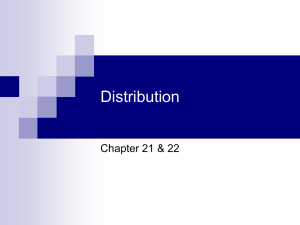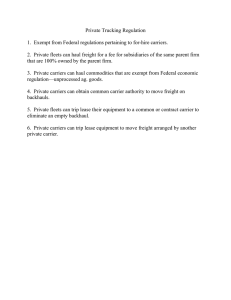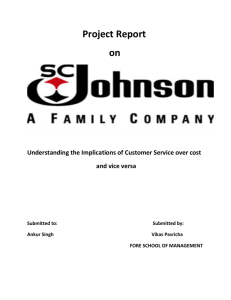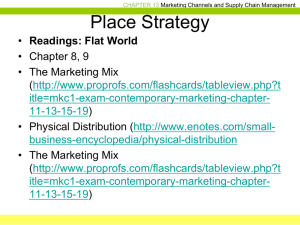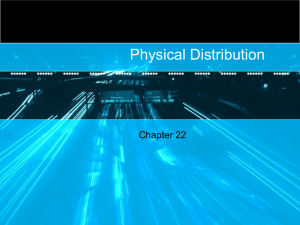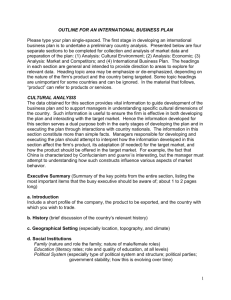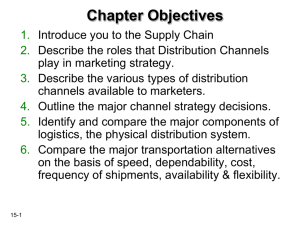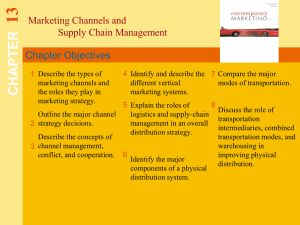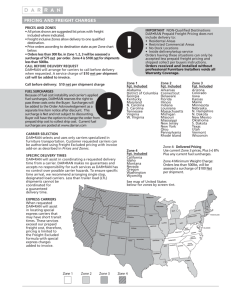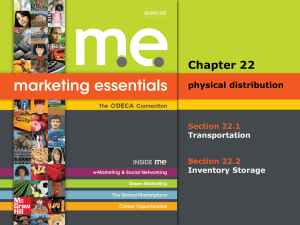Physical Distribution
advertisement
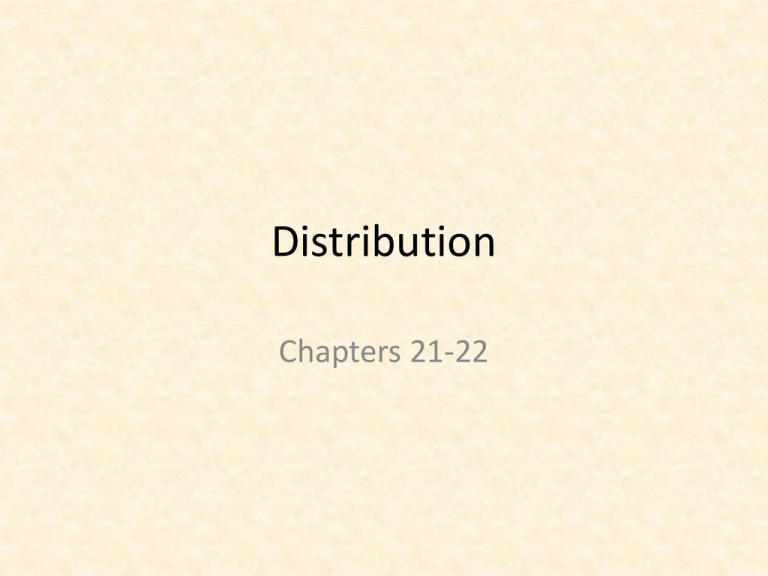
Distribution Chapters 21-22 Distribution – How It Works • Channel of Distribution: the path a product takes from producer or manufacturer to final user. • When the product is purchased from a business, the final user is classified as an industrial user. • When the product is purchased for personal use, the final user is classified as a consumer. – Example: shampoo products could be classified as both a consumer and industrial product. Manufacturers of Shampoo sell their product to the customer through retail operations. Channel Members • All businesses involved in a sales transaction that move products from the manufacturers to the final user are called intermediaries or middlemen. – Intermediaries provide value to producers because they often have expertise in certain areas that producers do not have. • Intermediaries provide the following roles: – Experts in displaying, merchandising, and providing convenient shopping locations – Reduce the number of contacts required to reach the final user of the product Channel Members • Wholesalers – buy large quantities of goods from manufacturers, store the goods, and then resell them to other businesses. – Two specialized wholesalers are called rack jobbers and drop shippers. • Rack jobbers: manage inventory and merchandising for retailers by counting stock, filling it when needed, and maintaining store displays. Examples: compact discs, hosiery, health products, and beauty aids. • Drop shippers: own the goods they sell but do not physically handle the actual products. Example: coal, lumber, chemicals that require special handling. Channel Members • Retailers – sell goods to the final consumer for personal use. – Sell goods to the customer from their own physical stores. – Serve as final link between manufacturer and consumer. – Provide special services, such as offering credit or providing delivery to help solidify customer relationships. • Types of retailers: brick and mortar, vending service, etailing,.s Channel Members • Agents: act as intermediaries by bringing buyers and sellers together. – Do not own the goods they sell. • Real estate agents, brokers, independent manufacturer’s representative (fishing rods, lures) • Brokers can be in the line of the food industry as well Direct and Indirect Channels • Direct distribution: when the goods or services are sold from the producer directly to the customer. • Indirect distribution: involves one or more intermediaries. – Example: independent insurance agent sells insurance policies from different insurance companies to consumers or businesses. Physical Distribution Chapter 22 Physical Distribution • All the activities that help to ensure that the right amount of product is delivered to the right place at the right time. • Involves moving products quickly with minimal handling to reduce costs and maximize customer satisfaction • 20-25 percent of the value of a product can be assigned to distribution expenses. Types of Transportation • Transportation: marketing function of moving products from a seller to a buyer. • Five major transportation forms that move products: 1. 2. 3. 4. 5. Motor carriers Railroads Waterways Pipelines Air carriers Trucking • Most frequently used form of transportation. • Carry higher-valued products that are expensive to carry in inventory. • Advantages – Convenient – Can deliver to any geographical location – door to door, wholesale or retail oriented – Can make rapid deliveries of large amounts of goods and reduce the need to carry large inventories between shipments. • Disadvantages – Delays due to traffic jams, equipment breakdown and accidents – Subject to size and weight restrictions enforced by states Rail Transportation • Major type in the US • Accounts for 38 percent of total intercity of freight. • Important for moving heavy and bulky freight such as coal, steel, lumber, chemicals, grain, farm equipment • Advantages – Can ship at low costs by handling large quantities – Seldom slowed or stopped by bad weather • Disadvantages – Lack of flexibility – Can pick up and deliver goods only at stations along designated rail lines – Can not reach as many places as motor carriers do Water Transportation • Oldest methods of transporting merchandise • Internal shipping from one port to another on connecting river and lakes. (Agricultural products get shipped from Midwest to other parts of the world) • Intracoastal shipping – between ports along the Atlantic or Pacific coasts • Advantages – Low cost – ships and barges are the cheapest form of freight transportation • Disadvantages – Slowest form of transportation – Buyers that are located far from port city must have products off-loaded from ships onto railroad cars or motor carriers to reach destination. – Water transportation is affected by bad weather. Great Lakes shipping is usually closed for 2-3 months in the winter. Pipeline • Normally owned by the company using them. Considered private carriers. • There are more than 200,000 miles of pipelines in the US • Most frequently used to transport oil and natural gas • Carry approximately 20 percent of the ton-miles of freight transported in the US • Advantages – Operational costs are small, but high initial investment – Risk of pipeline leak is small, but when a leak does occur the damage to the environment can be extensive. – Not subjected to delivery delays due to bad weather Air Transportation • Less than one percent of the total ton-miles of freight shipped • High value, low-weight items such as overnight mail are often shipped by air. • FAA regulates air transportation – does not regulate charges for air freight. • Advantages – Speed – Satisfies customers who need something quickly – Reduces inventory expenses and storage costs for warehousing products. • Disadvantages – Cost – Mechanical breakdowns and delays in delivery caused by bad weather. Inventory Storage • Storage is the marketing function of holding goods until they are sold. • Essential for most businesses – needs to store products until orders are received from customers. • Storing goods adds time and place utility to products. • Costs involved in storing products include space, equipment and personnel. Private Warehouses • A facility designed to meet the specific needs of its owner. • Valuable for companies that move a large volume of products. • Costly to build and maintain. • Stores that use private warehouses are: Sears, Radio Shack, Kmart. Public Warehouses • Offers storage and handling facilities to individuals or companies. • Available to any company that will pay for its use. • Public warehouses not only rent space but provide services to businesses. • Good for businesses that have low storage needs or seasonal production. Distribution Centers • Warehouse designed to speed delivery of goods and to minimize storage costs. • Planned around markets instead of transportation requirements. • Sherwin-Williams, Benjamin Moore paints, WalMart Distribution for International Markets • Critical in global marketing. • Exports now support one-sixth of the manufacturing and agricultural output of the US • Requires even more planning than for selling within domestic markets • Some countries have legal restrictions about how products may be transported • Businesses must understand other countries’ physical transportation systems.
